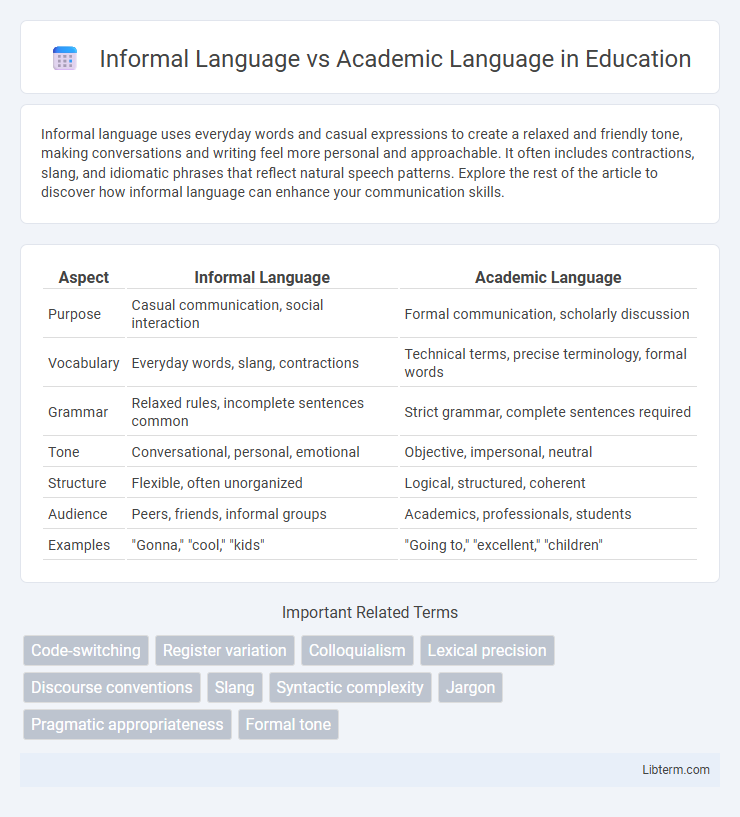Informal language uses everyday words and casual expressions to create a relaxed and friendly tone, making conversations and writing feel more personal and approachable. It often includes contractions, slang, and idiomatic phrases that reflect natural speech patterns. Explore the rest of the article to discover how informal language can enhance your communication skills.
Table of Comparison
| Aspect | Informal Language | Academic Language |
|---|---|---|
| Purpose | Casual communication, social interaction | Formal communication, scholarly discussion |
| Vocabulary | Everyday words, slang, contractions | Technical terms, precise terminology, formal words |
| Grammar | Relaxed rules, incomplete sentences common | Strict grammar, complete sentences required |
| Tone | Conversational, personal, emotional | Objective, impersonal, neutral |
| Structure | Flexible, often unorganized | Logical, structured, coherent |
| Audience | Peers, friends, informal groups | Academics, professionals, students |
| Examples | "Gonna," "cool," "kids" | "Going to," "excellent," "children" |
Understanding Informal and Academic Language
Understanding informal language involves recognizing casual expressions, slang, and conversational tone often used in everyday communication. Academic language requires precise vocabulary, formal grammar, and structured sentences to convey complex ideas clearly and objectively. Mastery of both language styles enhances effective communication across diverse contexts and purposes.
Key Differences Between Informal and Academic Language
Informal language employs colloquial expressions, contractions, and a conversational tone, often prioritizing ease of understanding and personal voice. Academic language relies on formal vocabulary, precise terminology, and structured sentences to convey complex ideas clearly and objectively. Key differences include the use of slang and idioms in informal language versus technical jargon and passive constructions in academic writing.
Common Features of Informal Language
Informal language features contractions, colloquial expressions, and simpler sentence structures that enhance casual communication. It often employs slang, idioms, and personal pronouns, creating a conversational tone that differs from the formal precision of academic writing. Informal language prioritizes ease of understanding and relatability over strict grammatical rules or technical vocabulary.
Essential Characteristics of Academic Language
Academic language is characterized by formal vocabulary, precise word choice, and complex sentence structures designed to convey ideas clearly and objectively. It employs specialized terminology, avoids slang or colloquialisms, and emphasizes evidence-based arguments and critical thinking. Clarity, coherence, and adherence to grammatical conventions are essential to maintaining professionalism and facilitating understanding within scholarly contexts.
Contexts for Using Informal Language
Informal language is typically used in casual contexts such as conversations with friends, social media interactions, and personal emails where a relaxed tone fosters approachability and quick communication. It features colloquialisms, slang, contractions, and idiomatic expressions that create a sense of familiarity and ease. This style contrasts with academic language, which is reserved for formal settings like research papers, presentations, and official documents requiring clarity, precision, and objectivity.
Situations Requiring Academic Language
Academic language is essential in formal settings such as research papers, scholarly presentations, and professional communications where clarity, precision, and credibility are paramount. It employs complex vocabulary, structured syntax, and objective tone to convey ideas effectively and meet disciplinary standards. In contrast, informal language suits casual conversations, social media, and everyday interactions but lacks the rigor needed for academic contexts.
Advantages and Disadvantages of Informal Language
Informal language offers advantages such as fostering relatability and ease of communication in casual contexts, enhancing social connections through relaxed expressions and slang. However, it lacks precision and formality, which can lead to misunderstandings or perceptions of unprofessionalism in academic or professional settings. The casual tone and colloquial vocabulary limit its effectiveness in conveying complex ideas or maintaining credibility in formal writing.
Benefits and Limitations of Academic Language
Academic language enhances clarity, precision, and formality in scholarly communication, making arguments more credible and well-structured. It supports the use of discipline-specific terminology that facilitates deeper understanding and critical analysis. However, its complexity and formality may limit accessibility and engagement for broader audiences unfamiliar with specialized vocabulary.
Tips for Transitioning from Informal to Academic Language
Mastering academic language requires focusing on formal vocabulary, precise grammar, and structured sentence construction. To transition effectively from informal to academic language, replace contractions and slang with formal alternatives, use third-person perspective instead of first or second person, and incorporate specific terminology relevant to your field. Practicing paraphrasing and engaging with scholarly texts enhances understanding and application of academic conventions.
Impact of Language Choice on Communication Effectiveness
Informal language relies on colloquialisms, slang, and contractions, which can enhance relatability and ease in casual conversations but may reduce clarity and professionalism in academic contexts. Academic language employs precise vocabulary, complex sentence structures, and formal tone to convey ideas clearly and authoritatively, ensuring accurate interpretation and credibility. Choosing the appropriate language style directly impacts communication effectiveness by aligning the message with audience expectations and context requirements.
Informal Language Infographic

 libterm.com
libterm.com